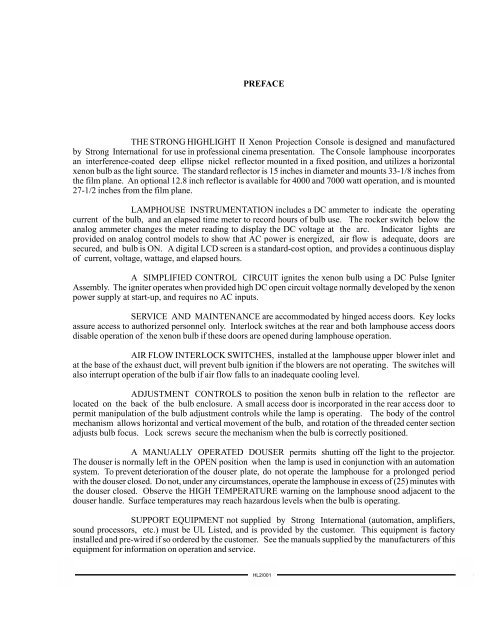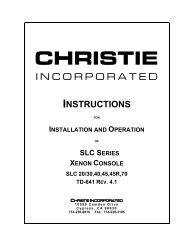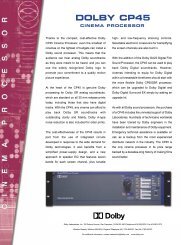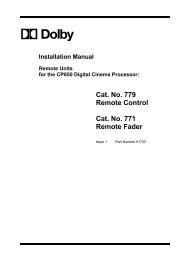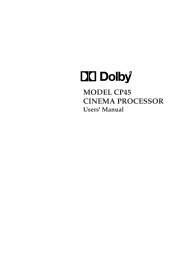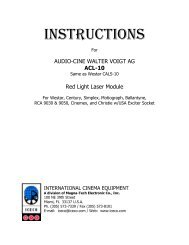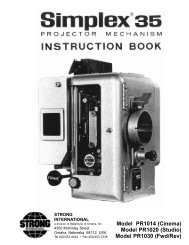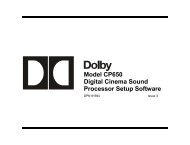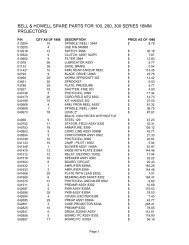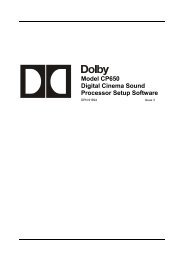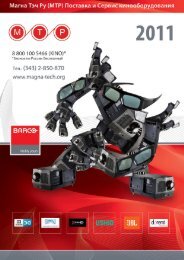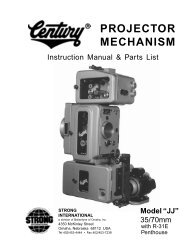PREFACE THE STRONG HIGHLIGHT II Xenon ... - Iceco.com
PREFACE THE STRONG HIGHLIGHT II Xenon ... - Iceco.com
PREFACE THE STRONG HIGHLIGHT II Xenon ... - Iceco.com
Create successful ePaper yourself
Turn your PDF publications into a flip-book with our unique Google optimized e-Paper software.
<strong>PREFACE</strong><strong>THE</strong> <strong>STRONG</strong> <strong>HIGHLIGHT</strong> <strong>II</strong> <strong>Xenon</strong> Projection Console is designed and manufacturedby Strong International for use in professional cinema presentation. The Console lamphouse incorporatesan interference-coated deep ellipse nickel reflector mounted in a fixed position, and utilizes a horizontalxenon bulb as the light source. The standard reflector is 15 inches in diameter and mounts 33-1/8 inches fromthe film plane. An optional 12.8 inch reflector is available for 4000 and 7000 watt operation, and is mounted27-1/2 inches from the film plane.LAMPHOUSE INSTRUMENTATION includes a DC ammeter to indicate the operatingcurrent of the bulb, and an elapsed time meter to record hours of bulb use. The rocker switch below theanalog ammeter changes the meter reading to display the DC voltage at the arc. Indicator lights areprovided on analog control models to show that AC power is energized, air flow is adequate, doors aresecured, and bulb is ON. A digital LCD screen is a standard-cost option, and provides a continuous displayof current, voltage, wattage, and elapsed hours.A SIMPLIFIED CONTROL CIRCUIT ignites the xenon bulb using a DC Pulse IgniterAssembly. The igniter operates when provided high DC open circuit voltage normally developed by the xenonpower supply at start-up, and requires no AC inputs.SERVICE AND MAINTENANCE are ac<strong>com</strong>modated by hinged access doors. Key locksassure access to authorized personnel only. Interlock switches at the rear and both lamphouse access doorsdisable operation of the xenon bulb if these doors are opened during lamphouse operation.AIR FLOW INTERLOCK SWITCHES, installed at the lamphouse upper blower inlet andat the base of the exhaust duct, will prevent bulb ignition if the blowers are not operating. The switches willalso interrupt operation of the bulb if air flow falls to an inadequate cooling level.ADJUSTMENT CONTROLS to position the xenon bulb in relation to the reflector arelocated on the back of the bulb enclosure. A small access door is incorporated in the rear access door topermit manipulation of the bulb adjustment controls while the lamp is operating. The body of the controlmechanism allows horizontal and vertical movement of the bulb, and rotation of the threaded center sectionadjusts bulb focus. Lock screws secure the mechanism when the bulb is correctly positioned.A MANUALLY OPERATED DOUSER permits shutting off the light to the projector.The douser is normally left in the OPEN position when the lamp is used in conjunction with an automationsystem. To prevent deterioration of the douser plate, do not operate the lamphouse for a prolonged periodwith the douser closed. Do not, under any circumstances, operate the lamphouse in excess of (25) minutes withthe douser closed. Observe the HIGH TEMPERATURE warning on the lamphouse snood adjacent to thedouser handle. Surface temperatures may reach hazardous levels when the bulb is operating.SUPPORT EQUIPMENT not supplied by Strong International (automation, amplifiers,sound processors, etc.) must be UL Listed, and is provided by the customer. This equipment is factoryinstalled and pre-wired if so ordered by the customer. See the manuals supplied by the manufacturers of thisequipment for information on operation and service.HL2/001
Run Halftone Plate HL2/002
RECEIVING & INSTALLATIONINSPECT <strong>THE</strong> SHIPMENT immediately and report any damage to the freight carrier. Itis the responsibility of the consignee, not the shipper, to press damage claims. Strong International willprovide shipping documents upon request.MOVE <strong>THE</strong> CONSOLE on its base pallet as far as possible to its intended location. Afterremoving the console from the pallet, install the four leveling pads and level the console to the booth floor.NOTE: If the booth floor is a soft material, such as linoleum, it is advisable to obtain four 4 inch x 4 inch x1/4 inch steel plates to place under the leveling pads to prevent “settling.”<strong>THE</strong> LEVELING FEET on the console are adjustable by loosening the locknut andraising or lowering the corner by turning the stud of the leveling foot with an end wrench. Retighten thelocknut after leveling the console.EACH CONSOLE is supplied with a soundhead spacer block to correctly position theprojector aperture at the specified working distance from the center of the lamphouse reflector. The makeand model of the soundhead and projector must be specified with the original equipment order to enableStrong International to supply the correct spacer block. The correct mounting hardware is supplied with thespacer block.PROJECTOR - SOUNDHEADSPACER BLOCKMANUFACTURER PART NO.Ballantyne 71229Simplex 71231Century 71231RCA 9030 71924Cinemeccanica V5 71722Cinemeccanica V8 23809USING <strong>THE</strong> CORRECT SPACER BLOCK and the soundhead mounting bolts provided,mount the soundhead to the projector mounting arm on the front of the console. This is most easilyac<strong>com</strong>plished by starting the top two bolts, through the washers and spacer block, into the back of thesoundhead casting. The soundhead can then be lifted into place, and the top two bolts into the soundheadcasting lowered into the slotted holes in the projector mounting arm. In this manner, the mounting arm willbear the weight of the soundhead while the two bottom bolts are started.TO AVOID CROSSTHREADING, the soundhead mounting bolts should be screwed infingertight as far as possible. Before tightening the bolts, check first the console, and then the projectormounting surface, for level.HL2/003
RECEIVING & INSTALLATION (continued)MOUNT AND ALIGN the projector in accordance with the manufacturer’s instructions.The 115 V.AC supply to the framing light, or the framing light transformer, may be derived from either theconvenience outlet or any of the 115 V.AC terminals on the main terminal board.<strong>THE</strong> FAN PANEL, located near the bottom of the off-operator side door, is equippedwith two six-inch (15.2cm) blowers for cooling a high reactance xenon power supply (when used). Checkthe molded plug electrical connections for good contact; vibration from shipping and handling may loosenthese connections.CORRECT INSTALLATION of the desired xenon bulb in the Highlight <strong>II</strong> is determined bythe size of the cathode support collet installed in the lamphouse. The collet installed is determined by thebulb model and type specified on the original equipment order. Open the lamphouse access door, remove thestainless steel bulb <strong>com</strong>partment cover, and examine the cathode support collet. Notify your StrongInternational Dealer if the collet is not appropriate to your desired xenon bulb.Bulb Collet Overall SocketWattage Part No. Length Diameter2000 & below 24179 5-3/8" (13.65cm ) .475" (12mm)2000, 3000 “HS” 24201 5-5/16" (13.50cm) .312" (8mm)2500 “HS” 24201 5-5/16" (13.50cm) .312" (8mm)3000 24180 4-3/8" (11.11cm ) .551" (14mm)4000-4500 “HS” 24181 4-1/4" (10.80cm ) .312" (8mm)5000 24433* 4-5/8" (11.75cm) .710" (18mm)7000 “HS” 24181 4-1/4" (10.80cm ) .312" (8mm)3000-7000 “H/VC” 24180 4-3/8" (11.11cm) .551" (14mm)* Osram XBO5000W/H OFR; other types, consult FactoryEXHAUST SYSTEM INSTALLATION:<strong>THE</strong> EXHAUST STACK of the console lamphouse is designed to fit an eight inch (200mm)diameter duct. This size ducting must be used throughout the entire system and installed to eliminate anypossibility of downdraft or rain dripping into the lamphouse. The exhaust blower must be capable of removing300 cubic feet (8.5 cubic meters) of air per minute, as measured at the exhaust stack. Install bypasses ratherthan dampers if it is necessary to restrict the air flow.IF MORE THAN ONE CONSOLE is installed in a <strong>com</strong>mon projection booth, theexhaust air flow must be measured at each individual console. Inadequate exhaust draft contributes topremature xenon bulb failure.IF REPLACING a carbon arc lamphouse, make certain that the entire exhaust system isthoroughly clean of all carbon ash or residue. Carbon residue falling on a xenon bulb will burn into the quartzenvelope and possibly shorten bulb life.HL2/004
WIRING INSTALLATIONALL INSTALLER CONNECTIONS to the Highlight <strong>II</strong> Console are made to the mainterminal board located behind the left (off-operator) door and blower panel toward the front of the unitadjacent to the xenon power supply.BECAUSE OF HIGH VOLTAGES impressed during the ignition cycle, the console must begrounded. Connect the ground wire to the grounding lug adjacent to the terminal board.<strong>THE</strong> AC REQUIREMENT for the Highlight <strong>II</strong> is a four-wire three phase line (three phaseplus neutral), with a separate earth ground. Voltage requirements are stamped onto the Name and Data Plate.All branch circuits are derived from this main input. The AC supply must be installed by a qualifiedelectrician in conformance to local codes. Hardware, wire sizes and conduit types must <strong>com</strong>ply with localcodes. A readily accessible disconnect device shall be incorporated in the AC supply line to permit the operatorto turn off all power to the console if required. Installer connections include three phase “hot” connections toTerminals 1, 2, and 3; 110 volt phase to Terminals 4 & 5, and a neutral connection to Terminal 6. See theattached Installation Diagram.AUTOMATION SWITCHING LEADS connect to the (2) terminal barrier strip adjacentto the AC input terminal board. Do not apply voltage to these terminals; a sustained dry contact rated at fiveamperes is required. The LAMP switch on the lamphouse control panel is provided for manual ignitioncontrol, and to act as an override in the event of an automation failure.8"AutomationTerminalsTiltLockAC Input TerminalBoard 71933HL2/005
THREEPHASEAC INPUT110 V.ACINPUT(20 A.)110 V.ACINPUT(20 A.)HL2/006
OPTICAL ALIGNMENT<strong>THE</strong> OPTICAL SYSTEM of every Highlight <strong>II</strong> Console is laser aligned at the factory inthe course of assembly and testing. This alignment procedure positions the reflector to best collect the lightgenerated by the xenon arc and project it to the film plane. The focal distance is the space between the arcand the reflector and is determined by the use of the correct bulb support collet. The working distance is thespace between the picture aperture and center hole of the reflector and is set by the installation of the correctsoundhead spacer block. See the preceding RECEIVING & INSTALLATION section for bulb supportcollet and spacer block part numbers.AN ALIGNING KIT (81906) is shipped with each console to enable field installation of aprojector and soundhead, or to reset the factory adjustments if disturbed in the course of shipping. Beforeinstalling the Aligning Kit, open the lamphouse douser, clear the projector shutter blades, open thechangeover douser, and tie the fire shutter (when used) open. Make certain the soundhead and projectormounting hardware is securely tightened.ReflectorCenteringPlugTestAperturePlateBurnerPlateAdjustingScrew(1 of 6)CordDummyLensWeightReflectorBulkheadCastingTie-DownScrew(1 of 2)WORKING DISTANCE: 33.125" ± .25"/84.15cm ± 6mm (15 inch Reflector)27.75" ± .25"/70.5cm ± 6mm (12.8 inch Reflector)Distance between “Centering Plug” & “Test Aperture Plate” = Working Distance<strong>THE</strong> DRAWING ABOVE illustrates the placement of the Aligning Kit <strong>com</strong>ponents. Tiethe cord off behind the reflector centering plug. Run the cord through the lamphouse snood, into theprojector, and through the film trap. Pass the cord through the hole in the dummy lens, and install the dummylens into the lens barrel. Attach a weigh to the end of the cord. The “weight” is supplied by the installer; useany object of adequate weight to hold the cord taut. Insert the tabs of the test aperture plate into the filmtrap. Close the projector gate to secure the test aperture plate.HL2/007
OPTICAL ALIGNMENT (continued)LOOK INTO <strong>THE</strong> REFLECTOR and locate the reflection of the aligning cord. When thereflector is correctly positioned, the actual cord will cover its own reflected image. If the reflected image isvisibly offset from the cord, a degree of re-adjustment must be performed.<strong>THE</strong> REFLECTOR BULKHEAD CASTING is fixed to the lamphouse burner plate andrequires no adjustment. The entire burner plate may be adjusted by loosening the (2) socket head tie-downscrews and shifting the burner plate on its base plate. Alternately tightening and loosening the (6) headlessadjusting screws will raise or lower the front or back of the burner plate. Carefully observe the string imagewhile adjusting the burner plate. When the “correct” (single-string) image is seen, and the cord remains in thecenter of the test aperture plate, secure the (2) tie-down screws, and tighten the (6) adjusting screw lock nuts.A SLIGHT DEGREE OF ADJUSTMENT is available by repositioning the soundheadmounting arm. To adjust, loosen the (4) hex head mounting screws and alternately tighten or loosen the (6)headless set screws around the perimeter of the base of the casting. Re-tighten the (4) hex head screws upon<strong>com</strong>pletion of the adjustments.REMOVE <strong>THE</strong> ALIGNING KIT COMPONENTS and restore operation of the projector fireshutter. Store the aligning kit parts in a secure location in the projection booth, as it may be necessary to againre-align the optical system if a replacement reflector is installed.RE-CHECK <strong>THE</strong> WORKING DISTANCE (33-1/8" or 27-3/4") after making any adjustmentto the reflector. Operating the lamphouse at the incorrect working distance can produce poor screenillumination or damage film.HL2/008
SAFETY PROCEDURES<strong>THE</strong> XENON BULB is highly pressurized. When ignited, the normal operating temperatureof the bulb increases the pressure to a level at which the bulb may explode if not handled in strict accordanceto the manufacturer’s operating instructions.mishandled.<strong>THE</strong> BULB is stable at room temperature, but may still explode if dropped or otherwiseREFER bulb replacement and service to QUALIFIED PERSONNEL with adequate protectiveclothing (face shield, clean cotton gloves, welder’s jacket). For routine lamphouse service, observe thefollowing rules:1. Allow the bulb to cool to room temperature before opening the lamphouse. Put on protective clothingdescribed above.2. De-energize the xenon power supply at the AC source before opening the lamphouse <strong>com</strong>partment.3. When possible, encase the bulb in its protective cover when cleaning or servicing the lamphouseinterior. The bulb, when outside the lamphouse, must be encased in the cover.4. Clean the bulb after it has cooled to room temperature. Do not touch the quartz envelope of thebulb; fingerprints will burn in and create hot spots which may shorten bulb life. If fingermarks aremade, they should be carefully removed with methyl alcohol and cotton prior to bulb operation.5. Never view an ignited bulb directly. BLINDNESS OR PERMANENT EYE DAMAGE MAY BEINCURRED.6. Use only xenon bulbs designated as OZONE FREE. When possible, vent the lamphouse exhaustto outside atmosphere.7. Maintain the lamphouse blower in good operating condition. Keep the blower inlet clean for unrestrictedair flow.8. To insure maximum bulb life, operate the lamphouse blower and the exhaust system for at least tenminutes after extinguishing the bulb.9. If returning a bulb for warranty adjustment, pack it in its original shipping container. Completeand return all required warranty information.SLX/003
SAFETY PROCEDURES (continued)10. Dispose of expired bulbs that are beyond warranty in the following manner: Wrap the bulb tightlyin several layers of canvas or heavy cloth. Place it on a hard surface and shatter the envelope witha sharp hammer blow. DO NOT place an unshattered bulb in an ordinary refuse container.11. DO NOT PERMIT UNAUTHORIZED PERSONNEL TO PERFORM OR ATTEMPT ANYPHASE OF XENON BULB HANDLING OR SERVICE.CATHODE PINCATHODEANODESEALANODE PINSEALCATHODE END CAPENVELOPEANODE END CAPSLX/004
XENON BULB INSTALLATION & OPERATIONOnly qualified and trained professional technical personnel are allowed to operate theequipment. Refer service and maintenance to trained personnel. Untrained personnelare not allowed in the projection booth during operation, service, or maintenance.OBSERVE ALL SAFETY PROCEDURES when working around the xenon bulb. Leavethe bulb in its protective plastic cover whenever possible, and remove immediately any fingerprints accidentallyplaced on the quartz envelope.OPEN <strong>THE</strong> LAMPHOUSE COMPARTMENT ACCESS DOOR and dismount the coverplate from the xenon bulb enclosure. Set the cover plate and thumb screws aside. Slide the contact clampon the igniter lead over the rear bulb socket.CONNECT <strong>THE</strong> ANODE LEAD to the positive (+) end cap of the xenon bulb if the leadis not factory attached. Tighten the connection firmly to insure a secure electrical contact and to preventoverheating.HANDLE <strong>THE</strong> BULB by the metal end caps only. Insert the bulb into the reflector, passingthe cathode (-) end cap through the center hole in the back of the reflector. Seat the cathode pin into thesocket of the rear bulb collet as far as possible to permit full focus travel. Rest the anode (+) end cap in thebulb support yoke in front of the reflector.SECURELY TIGHTEN the socket head clamping screw in the igniter lead contact clamp.Make certain the cathode (-) pin is firmly secured to the socket of the bulb collet. Attach the terminal of theanode (+) lead to the stud of the binding post located adjacent to the front bulb support. Dress the anode leadin front of the support yoke to minimize shadows. Tighten the fastening hardware securely to insure goodelectrical conduction.REMOVE <strong>THE</strong> PLASTIC COVER from the xenon bulb. Replace the cover plate over thebulb enclosure and secure with the thumb screws. Close and lock the lamphouse <strong>com</strong>partment access door.Turn on the lamphouse exhaust system.ENERGIZE <strong>THE</strong> CONSOLE AC INPUTS at the main breaker panel. Place theswitching circuit breakers in the ON position. Rocker-type switches (when used) will light when energized.The POWER light on the analog lamphouse control panel will glow, or the backlighting of the LCD screenon the digital control panel will glow (see below paragraph). The cooling fans will start. Operation of thecooling and exhaust blowers will actuate the air flow switch, lighting the AIR indicator on the analog controlpanel. The DOOR indicator light will glow on analog units when all access doors are closed and locked.UNITS EQUIPPED with the optional digital display include no indicator lights. POWERON state is indicated by the display being backlit and showing zero current and voltage. Failure to turn onexhaust air or to secure access doors is displayed as “CHECK EXHAUST” or “CHECK DOOR.” Aflashing asterisk (*) indicates that the display is active and awaiting inputs. NOTE: the interlock detectioncircuit in currently manufactured Digital Display models features a (5) minute “bobble” delay to allow theexhaust blower to reach full speed and eliminate air flow backdrafts.HL2/010
BULB INSTALLATION & OPERATION (continued)IGNITE <strong>THE</strong> XENON BULB by pressing the LAMP rocker switch on the lamphouse controlpanel. When this switch is closed, the LAMP ON indicator light will glow, and the lamphouse control circuitwill energize the coil of the xenon power supply contactor. When the initial high DC “no load” surge fromthe power supply reaches 130 volts, the DC Pulse Igniter will energize. The igniter will supply a highvoltage pulse across the electrodes of the xenon bulb.<strong>THE</strong> HIGH VOLTAGE IGNITER PULSE, coupled with the high DC open circuit (“no load”)voltage from the xenon power supply, will ignite the xenon bulb. A “cold” bulb will generally ignite after onepulse; a bulb still warm from prior operation may require two or three pulses. A short delay between ignitionpulses, as power supply capacitors re-charge, is normal.UPON IGNITION, the DC voltage will fall to the low sustaining level required for continuousoperation. The DC Pulse Igniter ceases operation below 130 V.DC. Allow a minute for the current tostabilize, and check the operating current on the ammeter. The ammeter, located on the analog lamphousecontrol panel, constantly displays the DC current supplied to the xenon bulb. Pressing the AMP/VOLTSswitch will momentarily display the DC arc voltage.<strong>THE</strong> OPTIONAL DIGITAL DISPLAY will continuously read out DC current, arc voltage,operating wattage, and elapsed time. No switching is required to change display modes. The flashing asterisksymbol (*) will turn into a plus (+) sign until the bulb is extinguished.ADJUST <strong>THE</strong> XENON POWER SUPPLY as required to provide the correct DC output tothe bulb. Directions for adjusting the DC output of the xenon power supply are included in the separateInstruction Manual furnished with the power supply. Do not exceed the maximum current specified for therated wattage of the bulb. See the warranty information packaged with the bulb and <strong>com</strong>ply with themanufacturer’s re<strong>com</strong>mendations. The following figures may serve as a guideline to <strong>com</strong>plete installation; inthe event of conflict, the bulb manufacturer’s figures shall prevail.Bulb Nominal DO NOTWattage Current EXCEED1000 50 A. 58 A.1600 65 A. 70 A.2000 75 A. 90 A.2500 90 A. 100 A.3000 95 A. 100 A.4200 135 A. 150 A.5000 145 A. 155 A.7000* 150 A. 160 A.* Minimum Aperture: 70mm. Radiant Energy levels will damage 35mm prints.HL2/011
BULB INSTALLATION & OPERATION (continued)A NEW BULB is normally operated at or slightly below the “nominal” current level. As thebulb ages, the quartz envelope will darken and the light output will decrease. To restore the light output, theoperating current can be gradually increased to, but not exceeding, the maximum current. Because of manufacturingtolerances on xenon bulbs, one lamp in a two-machine booth may operate at a slightly higher orlower current setting than the other to balance the light on the screen.ONCE OPERATING at its correct current setting, the xenon bulb must be positioned insidethe reflector to project its optimum light field. The bulb positioning mechanism is mounted to the back of thebulb enclosure inside the lamphouse <strong>com</strong>partment, and is accessible through the small hinged door in the rearconsole access door.<strong>THE</strong> CENTER SECTION of the control is a threaded member that focuses the bulb inrelation to the reflector. Turning this adjustment moves the bulb in only one plane, into or away from thereflector. Clockwise rotation moves the bulb away from the reflector. The small knurled screw to the leftof this section can be tightened to lock the focusing mechanism, after the following procedures have been<strong>com</strong>pleted.<strong>THE</strong> THUMB SCREWS on either side of the focusing control lock the horizontal andvertical adjustment mechanism in position. The thumb screws are spring-loaded to apply a degree of tensionbetween the mechanism housing and the back of the bulb enclosure.REMOVE <strong>THE</strong> PROJECTION LENS, start the projector motor and open the lamphousedouser. Since a xenon light source can be focused to a small, intense spot at the projector trap, do notoperate the lamp with the douser open without first starting the projector motor.<strong>THE</strong> IMAGE projected to the screen, without the projection lens, is that of the center holeof the reflector, and the shadow of the anode (the larger of the two electrodes in the xenon bulb). Theprojection of the anode shadow will appear on the screen as a darker spot surrounded by the grey area of thereflector center hole.HL2/012
BULB INSTALLATION & OPERATION (continued)TURN <strong>THE</strong> CENTER FOCUSING SECTION of the bulb positioning control until the smallestblack spot obtainable is focused on the projection screen. It may be best to run this adjustment bothdirections to permit positive identification of the spot. The position of the spot may be to the right, left, topor bottom of the screen, and not necessarily at the center.LOOSEN the two thumbscrews, one on either side of the focusingsection just enough to permit manual movementof the <strong>com</strong>plete assembly. The bulb adjustmentcontrol will now move about these twothumb screws, and as this control is shifted,the smooth shadow of the electrode can be seenextending beyond the projected hole in thereflector. The electrode shadow must becentered in the projected hole of the reflector.Anode SupportShadowReflector HoleShadowAnodeShadowPROJECTED IMAGE (without Lens)MOVE THIS CONTROL SECTION around the twothumb screws until the black spot is as round as possible to project. Thetwo thumb screws are spring-loaded to apply a degree of tension to thecontrol section. It may be necessary to again adjust the focus control todefine a sharp spot. If the bulb adjustment control is at its extreme limitof travel (left-to-right or top-to-bottom), shut off the lamp, allow thebulb to cool, and open the lamphouse door. Remove the stainless steelbulb enclosure cover and loosen the set screw securing the front bulbyoke. Re-position the yoke left-to-right or up-and-down to <strong>com</strong>pensate.<strong>THE</strong> FRONT BULB SUPPORT YOKE is adjustable and isfactory-set to ac<strong>com</strong>modate the end cap diameter of the xenon bulb specifiedon the sales order. A height of 3-1/8 to 3-1/4 inch is normal for most<strong>com</strong>monly used bulbs, but bulbs with larger diameter end caps (i.e. ORC4500 and 7000 watt models) may require setting the yoke as low as threeinches. To adjust the yoke position, loosen the set screw in front of theyoke, and raise or lower the yoke as required. A hex nut is provided tolock the height once selected. Re-tighten the set screw when finished.AFTER <strong>THE</strong> BLACK SPOT is as even around the outsideas possible to project, and centered in the shaded area as shownabove, tighten the two thumb screws to lock the adjustment section.This adjustment has now centered the projected image of the electrodeshadow and the hole in the reflector on the aperture and screen. If thespot raises or lowers as the focus screw is turned, it is necessary to readjustthe front bulb yoke as instructed above.HL2/013
BULB INSTALLATION & OPERATION (continued)TO ALLOW FOR MANUFACTURING TOLERANCES in overall bulb length and/orfabrication of the stainless steel bulb enclosure, an additional degree of fine adjustment is available by changingthe position of the snap ring(s) retaining the bulb support collet in its bearing. Use this feature only if theproper focal position cannot be gained by use of the focus screw.TO REPOSITION <strong>THE</strong> COLLET, extinguish the bulb and allow the lamp to cool. Observingall safety precautions, remove the xenon bulb. From the rear of the bulb enclosure, remove the 21-48027Snap Ring (see Detail drawing, Figure 3 Parts List) and withdraw the collet from the inside of the bulbenclosure. Position the inner snap ring as required, and re-install the collet by securing the outer snap ring.IF <strong>THE</strong> PROJECTED IMAGE is not centered on the screen as illustrated, move the consoleor adjust the tilt to correct. It is necessary to dismount the off-operator side blower panel to access the left tiltlock. See the illustration on the WIRING INSTRUCTIONS page.REPLACE <strong>THE</strong> PROJECTION LENS and install a CinemaScope aperture plate. Turnthe center focus adjustment until the desired light distribution is projected to the screen. Avoid running theprojector in this manner for an extended period of time without frequently closing the lamphouse douser.Without film, the heat from the xenon bulb can damage the projection lens.<strong>THE</strong> IDEAL “FLAT” FIELD denotes a pattern of light without a distinct “hot” spot inthe center of the screen, and only a slight reduction of light in the four corners. Establish the desired fieldusing the 35mm CinemaScope aperture plate, and DO NOT alter the bulb focus when projecting a “flat”35mm print. An optional Beam Expander Kit is required for 70mm operation; see the following sectionentitled “70mm OPERATION” for further details.IF A “HOT” SPOT REMAINS in an otherwise even field, turn the LAMP switch OFF andallow the xenon bulb to cool. Open the access door and remove the side cover plate of the bulb <strong>com</strong>partment.Loosen the set screw locking the position of the bulb support yoke, and move the yoke to “point” the front endcap of the bulb away from the “hot” spot. Replace the bulb <strong>com</strong>partment cover, close and lock the accessdoor, and re-ignite the xenon bulb. Repeat the manipulation of the bulb adjustment mechanism to establishan even field.TO EXTINGUISH the xenon bulb, turn the LAMP rocker switch on the lamphousecontrol panel to its OFF position. The LAMP ON indicator light (when used) will extinguish. Leave theconsole power ON to permit the blowers to operate and cool the bulb. Allow the blowers to operate for atleast ten minutes after turning off the xenon bulb. A forced-air cooling cycle is required by xenon bulbmanufacturers in order to <strong>com</strong>ply with bulb warranty requirements.RECORD <strong>THE</strong> HOURS of xenon bulb operation on the inside back cover of this manual.Use the (HR) figure displayed on the digital unit, as this figure indicates total system hours. Instructions forre-setting the (BLB) display follow in the DIGITAL DISPLAY section.HL2/014
BULB INSTALLATION & OPERATION (continued)WHILE XENON BULBS generally will perform well beyond their stated warranty life, nocredit will be allowed by the bulb manufacturer for damaged reflectors in the event of an explosion if the bulbis past its warranty period. This should be considered when determining the time of bulb replacement.UPON REPLACING <strong>THE</strong> XENON BULB, it will be necessary to repeat only the bulbalignment procedures outlined above. Adjustments detailed in the OPTICAL SYSTEM ALIGNMENTsection are required only when a reflector is replaced.BULB ROTATION:MOST XENON BULB MANUFACTURERS re<strong>com</strong>mend and/or require rotation of horizontalbulbs at 50% warranty life. Refer to the warranty information packaged with the xenon bulb forspecific requirements.TO ROTATE <strong>THE</strong> BULB, loosen the socket screw in the cathode clamp and remove theanode lead terminal from the positive binding post. Rotate the bulb 180 degrees, re-attach the anode leadterminal, and tighten the cathode clamping screw.IF <strong>THE</strong> BULB’S ANODE LEAD is too short to reach the binding post from the rotatedposition, an anode lead extension with fittings is available from Strong International Dealers. Order (1) eachof Lead Extension 71928, Connector 81349, and Insulation Tubing 71289.ADJUST <strong>THE</strong> XENON POWER SUPPLY to increase operating current to or just belowthe maximum level specified for the bulb. Project a white light to the screen to check for an even field andcorrect the bulb positioning as required. Operate the xenon bulb at this higher current level for one or twoperformances, and then return the power setting to its previous level. Temporary operation of the bulb at highcurrent following bulb rotation will restore the cathode tip and enhance ignition at the new arc position.BULB WARRANTY RETURNS:RETURN BULBS upon which a warranty claim is being made to the theatre equipmentdealer through whom the bulb was purchased. Pack the bulb in its original shipping carton with the protectivecover over the bulb. Complete and enclose all warranty forms supplied by the bulb manufacturer.WARRANTY CREDIT will not be allowed if the bulb failure is related to mishandling,incorrect installation, faulty supporting equipment, or abuse.REFLECTORS damaged by a bulb explosion should be forwarded to the bulb supplier forwarranty adjustment. Include an invoice copy authenticating the cost of the replacement reflector.HL2/015
ARC STABILIZING MAGNET ADJUSTMENT<strong>THE</strong> ARC STABILIZING MAGNET is located on the lamp base in front of the reflector.This magnet is preset at the factory and should not require adjustment.IF IT SHOULD BECOME NECESSARY to adjust the magnet, the following proceduremust be followed. Observe all safety procedures when working in the lamphouse <strong>com</strong>partment.<strong>THE</strong> NORMAL ARC, when viewed through the arc viewing port, will appear as inFigure A. This represents the correct magnet position.FIGURE B shows the position of the arc when the magnet is too low. Raise the magnet onits adjustment bracket to lower the arc to the position illustrated in Figure A.FIGURE C shows the position of the arc when the magnet is too high. Lower the magnetto raise the arc to the position illustrated in Figure A.<strong>THE</strong> MAGNET must always be installed with the longest portion of the magnet nearestthe bulb, and with the SOUTH (S) pole pointing to the operator side access door. Reversing the magnet willcause bulb flicker, and may inhibit bulb ignition.IN NEW EQUIPMENT, the magnet is normally in the center of the adjustment range.Changes in the magnet position are required only to correct an improperly burning arc (Figure B or C).ANY REPLACEMENT MAGNET should first be installed in the center position of theadjustment range. Raise or lower the magnet as required to center the arc as illustrated in Figure A.HL2/016
70mm OPERATIONBECAUSE OF <strong>THE</strong> LARGER APERTURE AREA of a 70mm projector, it is necessary toincorporate a beam expander lens to insure proper coverage of the screen. The Beam Expander Kit No.40959 is factory installed when ordered with new equipment, or may be added to an existing installation at alater date.<strong>THE</strong> KIT consists of a lens holder (81847) which mounts to the front casting of the lamphousewith three 1/4-20 x 1-1/8" hex head screws (705) and three 1/4" washers (863), a lens assembly(81848), and a nose cone (40960). The sheet steel nose cone mounts to the lens holder with three 6-32 x1/8" pan head screws (1412).FLAT Surface of Lenstoward ScreenRotate Handle DOWNto StopALL CONSOLE front castings are drilledand tapped to ac<strong>com</strong>modate field installation of theBeam Expander Kit. The nose cone can be trimmedwith tin snips to fit as required without disturbing the33-1/8 inch working distance of the lamphouse reflectorto the projector aperture.<strong>THE</strong> 70mm LENS is inserted as illustratedONLY for 70mm operation; DO NOT insert the lensfor 35mm projection.MINOR REFOCUSING of the bulb may be required after insertion of the beam expanderlens. Prior to projecting the 70mm film, project a white light to the screen with the projector running. Adjustthe center member of the bulb adjustment mechanism until the desired light distribution is projected to thescreen. Again, avoid running the projector in this manner for a prolonged period without frequently closingthe douser to cool the projection lens.<strong>THE</strong> BEAM EXPANDER LENS should be cleaned periodically with lens tissue and a lenscleaning solution suitable for coated lens.LENS HOLDER 81847, as illustrated above, can also be used with a Heat Filter & RingAssembly (40939) when running 35mm prints. This optional heat filter may be desirable if a high wattagebulb (4500-5000 watt) is routinely used for 35mm projection.HL2/017
MAINTENANCEWARNING: OPEN AC DISCONNECT BEFORE SERVICING UNIT.<strong>THE</strong> <strong>STRONG</strong> <strong>HIGHLIGHT</strong> <strong>II</strong> CONSOLE requires very little maintenance to keep it ingood working order. Routine cleaning of the equipment is the most important element, and cleaning intervalsare determined by the dirt and dust conditions at the installation site.<strong>THE</strong> REFLECTOR should be cleaned with a soft, clean, dry cotton cloth every two weeks. Ifexcessively soiled, a <strong>com</strong>mercial liquid glass cleaner may be used. Use no abrasives. Exercise extreme carenot to scratch or fingermark the coated surface.CHECK ALL ELECTRICAL CONNECTIONS periodically for tightness. Particular attentionshould be paid to the DC connections at the bulb, the shunt, and the positive binding post.<strong>THE</strong> BULB should be checked regularly for presence of dirt or foreign material on theenvelope. Dirt or foreign material must be removed from the bulb immediately, or they will burn into thequartz envelope and shorten bulb life. NOTE: Observe all safety procedures when working around the bulb.<strong>THE</strong> INSIDE of the lamphouse <strong>com</strong>partment and the blower intakes should be cleanedperiodically, depending on the dust conditions at each installation. Keep all air inlet grilles clean and freefrom obstructions.BOTH <strong>THE</strong> FRONT AND TOP LAMPHOUSE BLOWERS require periodic lubrication.Oil holes in the blower motor end bells are marked, and use of a squeeze-type, plastic injection oiler isre<strong>com</strong>mended. NOTE: blower motors are thermally protected, and failure to routinely service them couldcause overheating and periodic shutdowns. Interruption of the air flow will open lamphouse interlockswitches and extinguish the xenon bulb.TO EXPOSE <strong>THE</strong> OIL HOLES of the front blower, dismount the motor cover by removingthe two mounting screws. Both oil holes of the top blower motor are accessible by removing the frame andgrille assembly from the off-operator side of the top blower cover. Apply a few drops of machine oil in eachoil hole once or twice a year. Wipe off excess oil to prevent dust attraction.TWO SIX-INCH BLOWERS at the bottom of the off-operator side panel are required onlywhen the console uses a high reactance xenon power supply. These blowers, like the built-in blowers usedin the switching power supply, utilize sealed bearings and require no lubrication.HL2/018
DIGITAL DISPLAYUPON ENERGIZING the LAMP circuit, the backlighting will illuminate the LCD screen.When all blowers are operating and all access doors are closed and correctly secured, the display will appearsimilar to the example shown:000V 000A 0000W1234BLB 12345HR *FOR PURPOSES OF ILLUSTRATION, the above display indicates a non-operating bulbwith 1,234 hours of use installed into a console with 12,345 hours of operation. The asterisk (*) at the end ofthe second line, when flashing, indicates that the display is active and awaiting input. Upon bulb ignition,the upper line will display the arc voltage (V), the DC current (A), and the operating wattage (W) of thebulb. The figures will shift for the first few moments of bulb operation, but will stabilize after the bulb reachesoperating temperature and pressure. A plus symbol (+) will replace the flashing asterisk.IN <strong>THE</strong> EVENT of an open interlock switch, the lower line will display the appropriatediagnostic measure, i.e. CHECK REAR DOOR or CHECK EXHAUST. Diagnostic messages are oftenabbreviated, and are defined as follows:CHECK REAR DOOR:CHECK FRONT DOOR:CHECK NONOP DOOR:CHECK EXHAUST:CHECK TOP BLOWER:Make certain the rear console access door is closed, locked, and thelocking screw into the lock plate is installed (if unit is equipped with mechanicalinterlock switches).Make certain the operator’s lamphouse access door (right side, viewedfrom rear) is closed, locked, and the locking screw into the (mechanical)lock plate is installed.Make certain the lamphouse access door on the off-operator (left) side isclosed, locked, and the locking screw into the (mechanical) lock plate isinstalled.Make certain the exhaust blower has been switched on and is operatingwithout obstruction. A five minute “bobble” delay in this circuit permits theexhaust blower to reach full speed and eliminate air flow backdrafts.Make certain the large squirrelcage blower on the top of the console isenergized and operating, and that the ducting to the bulb <strong>com</strong>partment issecure.WHEN <strong>THE</strong> INTERLOCK CIRCUIT is <strong>com</strong>plete, closure of the LAMP switch, or theautomation closure, will energize the contactor of the xenon power supply. The high open circuit (“no load”)DC voltage will be displayed. When the open circuit voltage reaches 140 V.DC, the igniter will generatea RF pulse to bridge the gap between the bulb electrodes. This pulse, coupled with the high open circuit DCvoltage, will ignite the bulb. The voltage reading will then fall to the bulb’s sustaining level, and the DCamperes (A) and wattage (W) will be displayed continuously until the bulb is extinguished. The flashingasterisk symbol (*) will be<strong>com</strong>e a plus (+) sign.HL2/019
DIGITAL DISPLAY (continued)ELAPSED HOURS will begin counting upon bulb ignition. Bulb hours (BLB) are limitedto four digits, and can be re-set when the xenon bulb is replaced. To re-set bulb hours, press and hold (for 3seconds) the RESET button accessible through marked hole below the LCD screen. The 5/64" allen wrenchused to tighten the front bulb yoke set screw is the correct diameter to clear the hole. NOTE: when recordingstart-up and removal hours on the <strong>Xenon</strong> Bulb Record, use the total elapsed hours (HR) figures. The (BLB)figure, re-set upon installation of the bulb, is a convenience feature ONLY. Basing records of the lamp systemon the total hours (HR) figures permits an accurate and ongoing history of bulb usage.LCD screen:IF <strong>THE</strong> XENON BULB fails to ignite, additional diagnostic messages will display on theCHECK PWR SUPPLY:CHECK IGNITER:If no DC current is sensed, and voltage does not exceed 125 V.DC, check thexenon power supply. Repair or replace as required.If the DC open circuit voltage reaches and exceeds 140 V.DC and the igniterfails to pulse, replace the igniter.PRESSING and rapidly releasing the RESET button will display the last recorded diagnosticmessage. The message will be erased after power is shut off. NOTE: Pressing and holding the RESET buttonwill set the BLB display to zero.DIAGNOSTIC MESSAGES serve as prompts and suggestions but do not replace traditionaltroubleshooting procedures. If an access door is closed and secured but transmits an error message, checkthe subject door interlock switch with an ohmmeter and replace if defective. Dirt or dust fouling an air vaneswitch will cause a “blower” or “exhaust” error message. A “power supply” or “igniter” error message mightbe caused by a loose or oxidized connection.HL2/020
<strong>HIGHLIGHT</strong> <strong>II</strong> LAMPHOUSE<strong>Xenon</strong> Bulb Ignition& Monitor CircuitHL2/021
24250 LAMPHOUSE WIRE HARNESSThe Highlight <strong>II</strong> Lamphouse Wire Harness Assembly is designed to permit use of either the Analog orDigital Control Panel without revision to lamphouse wiring. See Figure 2 for details of the two Control Panels.Individual <strong>com</strong>ponent parts (switches, etc.) of the 24250 Wire Harness are available as replacementparts. See the Parts List following the Wiring Diagrams.24250 Wire HarnessPage 1 of 2HL2/022
HL2/02324250 Wire HarnessPage 2 of 2
24275 Voltage DividerPCB Assembly(mounts to R1 Shunt)Cut this jumper for use withDIGITAL Control PanelCut this jumper for use withANALOG Control PanelHL2/024
PARTS LISTLamp Control Wire HarnessAssembly No. 24250Ref.Desig. Part No. DescriptionIGN 39862 DC Pulse Igniter Assembly- 39875 Igniter Case & Coil, Potted Assembly- 62-87004 Igniter Printed Circuit Board AssemblyJ1 21-37058 Connector, (8) PositionJ3 21-37055 Connector, (2) PositionJ5 21-37056 Connector, (3) PositionJ10 21-37057 Connector, (5) PositionJ12 21-37057 Connector, (5) PositionMSW1 85109 Microswitch, Air Flow; Top BlowerMSW2 85109 Microswitch, Air Flow; Exhaust StackMSW3 78133 Microswitch, Air Flow; Front Blower (early models)R1 82167 Shunt, 200 A. 50 mV.S1 24406* Door Interlock Switch, Lamphouse Access,Operator SideS2 24406* Door Interlock Switch, RearS3 24406* Door Interlock Switch, Lamphouse, Off-Operator SideX1 11-64004 Transformer, 110/220 V.— 56428A Terminal, Spade Lug— 41-62027 Terminal, Auto Clip (Push-On)— 80195A Terminal, Ring— 81252 Butt Splice Connector (Small)— 94262 Butt Splice Connector (Large)— 24395 Wire Harness, Lamphouse DC (with MS Connector)* Replaces 39260 used on earlier models. See Figures 3 & 4.See 24406 Detail drawing on Figure 4 Parts List.Voltage Divider PCBAssembly No. 24275Ref.Desig. Part No. DescriptionC1-C5 61-08025 Capacitor, .005 µf, 3 kV.D1-D4 51-17001 Diode, 1N4007PCB 24274 Printed Circuit Board (less Components)R1 61-46002 Resistor, 100 Ohm, ¼ Watt 5%R2 61-46043 Resistor, 100k Ohm, ¼ Watt 5%J1 21-37051 Connector, (5) PositionHL2/025
23976 DIGITAL DISPLAY CONTROL PC BOARDWiring DiagramPage 1 of 3HL2/026
23976 DIGITAL DISPLAY CONTROL PC BOARDWiring DiagramPage 2 of 3HL2/027
23976 DIGITAL DISPLAY CONTROL PC BOARDWiring DiagramPage 3 of 3HL2/028
ANALOG LAMPHOUSE CONTROL PANELAssembly No. 23236See Figure 2 for Parts List.HL2/029
TROUBLESHOOTINGIN <strong>THE</strong> EVENT of an ignition failure, check first the indicator lights mounted to the analogLamp Control Panel. The digital display will read out items to inspect and conditions to correct.INDICATOR LIGHT FUNCTIONS: (Analog Units)“POWER”“LAMP”“AIR”“DOOR”When lit, AC power is supplied to the lamphouse, and to those branch circuits of the consolewhich are switched ON. The lamphouse blowers will operate.This indicator lights only when the control circuit is <strong>com</strong>plete, meaning all access doors areclosed and locked, and the bulb seal blowers are operating and supplying adequate air flowacross the xenon bulb. This light also indicates that the xenon power supply contactor is pulled,and DC current is applied to the xenon bulb.Closure of the air flow switches, indicating adequate ventilation, will light this bulb. Airflow switches are located inside the bulb <strong>com</strong>partment at the top blower outlet and at theexhaust stack.The (3) door interlock switches, at both operator lamphouse access doors and the at rear door,must be closed and locked to actuate this light. Locking screws, when supplied with mechanicalinterlock switches, must secure access door lock tabs. Magnetic interlock switches do notrequire locking screws, but key locks must be secured to insure switch closure.The “POWER,” “AIR,” and “DOOR” indicators on the analog control panel must all belighted to indicate that conditions are correct for ignition of the xenon bulb. The MAIN LINE circuit breakermust be in the ON position. The “LAMP” indicator (analog units) lights only when the circuit for bulbignition is <strong>com</strong>plete.The elapsed time meter indicates running time only when the xenon bulb is operating. Thisprovides an accurate record of bulb life. A defective elapsed time meter will not prevent bulb ignition.The control circuit of the Strong Highlight <strong>II</strong> operates on 115 V.AC. Exercise extremecaution when taking readings inside the console enclosure. Do not open the lamphouse enclosure until thebulb has cooled to room temperature and the power supply and igniter capacitors have drained for (10)minutes.Observe all safety procedures when working around the xenon bulb. If the quartz envelopeof the bulb is accidentally touched, remove all fingerprints with alcohol before igniting the bulb.HL2/030
TROUBLESHOOTING (continued)NORMAL OPERATION:The igniter operates from the high DC open circuit voltage furnished by the xenon powersupply when energized. The 115 V.AC control circuit (5 & 6), which is energized when interlock and air flowswitches are closed, and the LAMP ON closure is <strong>com</strong>pleted, actuates the power supply contactor. Theigniter then generates the high voltage RF pulse to bridge the bulb arc gap. The RF pulse, <strong>com</strong>bined with thehigh open circuit DC voltage, are necessary to ignite the bulb.To ac<strong>com</strong>odate different open circuit voltage characteristics, (2) DC Pulse Igniter Assembliesare available for use in the Highlight <strong>II</strong> console. Units equipped with switching-type xenon power supplies useIgniter 39862, and consoles with high reactance power supplies use 39865. Check the Part Number stampedon the case of the igniter.There will be a distinct buzzing sound at the moment the xenon bulb ignites. This is causedby the spark gap in the igniter, and the high voltage arc between the bulb electrodes.A short delay (two to three seconds) between contactor closure and the ignition pulse is notabnormal. This delay allows power supply capacitors to charge. A similar delay between strikes is normalin the event multiple ignition pulses are needed; a “warm” bulb, or a bulb nearing expiration, sometimesrequire more than one ignition pulse.When the bulb ignites, the DC voltage drops to normal bulb operating range. The igniterceases operation at voltages below 130 V.DC.VISIBLE INDICATIONS OF MALFUNCTION: (Analog Control)1. No “POWER” light. Check main circuit breaker or fuse; check AC supply at source.2. No “AIR” light. Check bulb seal blowers; replace, repair, clean or lubricate as required. Check airvane switches (0 Ohms across contacts).3. No “DOOR” light. Side or rear access doors open or unlocked. Defective interlock switch; checkwith ohmmeter for <strong>com</strong>plete closure.4. No “LAMP” light. Assuming all other indicator lights are ON, check for loose or missing connectionin the 5 & 6 circuit; failure in automation circuit.DIGITAL DISPLAY units will read out sequential inspection points and tests.Bulb Fails To Ignite1. No DC current. Switch MAIN LINE breaker ON.2. Low DC no load voltage from xenon power supply. Check no load voltage by holding VOLTAGEswitch and pressing “LAMP” switch (or observe digital display). Repair or replace power supply if noload voltage does not reach 140 V.DC.HL2/031
TROUBLESHOOTING (continued)Bulb Fails To Ignite (continued)3. Defective xenon bulb. Check for damaged or scorched electrodes, discolored quartz envelope or endcaps. Replace if defective.4. Faulty igniter. Arc at spark gap should be audible, and arc across bulb electrodes should be visiblethrough arc viewing port. Repair or replace.5. Incorrect igniter assembly. Consoles with switching power supplies use 39862; consoles with high reactancepower supplies require 39865. Check Part Number stamped on igniter case.6. DC output level too low. Increase power supply to rated bulb current.7. Faulty automation contact. If lamp ignites by means of the “LAMP” switch, but fails to igniteautomatically, check automation controller.8. Loose or faulty terminal connection. Visually inspect connections, particularly in AC circuit (5 & 6)and all DC connections.9. Ignition pulse arcing to ground. Dress all igniter and bulb leads away from grounded metal lamphouse<strong>com</strong>ponents.Bulb Goes Out During Operation1. Blocked bulb seal blower intake or defective blower motor. Clean or replace.2. Air flow switch sticking or faulty. Clean or replace.3. Exhaust system malfunction. Check for correct exhaust blower operation; unobstructed air flow throughducting.4. Overheated thermal switch in xenon power supply. Check for unobstructed air flow through powersupply; loose DC connection(s).5. Blower motor overheated, internal thermal switch open. Allow to cool; clean and oil as required.6. Faulty automation contact. If lamp operates normally in “manual” mode (using “LAMP” switch),check automation controller relay.7. Faulty xenon bulb. Check for damaged electrodes, darkened envelope, instability in operating current orvoltage. Replace if defective.8. Phase loss or unstable AC source. See xenon power supply manual; Strong switching power suppliesfeature Phase Loss Detection and Brown-Out Protection circuits.Excessive Light Flicker1. Defective xenon bulb. Check for cracked and/or sagging electrode.2. Arc stabilization magnet missing or reversed. Replace or correct.3. Projector shutter mis-timed. See projector manual.4. Rectifier diode open or shorted (high reactance supply). Replace as required.5. Excessive ripple in power supply DC output. Consult factory.HL2/032
TROUBLESHOOTING (continued)Reduced Light Output1. Normal bulb aging. Increase current. Do not exceed maximum current rating specified by bulbmanufacturer.2. Defective bulb. Check for discoloration or premature darkening of envelope.3. Bulb defocused or misaligned.Noise in Theatre Sound System During Bulb Ignition or Operation1. Defective RF suppression capacitor on Voltage Divider PCB. Check with capacitor tester and replaceif defective.2. Console or sound system not correctly grounded. Connect to adequate earth ground.Excessive Heat at Film Trap (Film Burning)1. <strong>Xenon</strong> bulb misfocused. Focus bulb for even field using CinemaScope aperture plate; do not hot spotscreen center.2. Dichroic coating on reflector peeled. Replace reflector.3. Excessive bulb wattage. DO NOT EXCEED 4500 watts for 35mm projection. Air or water-cooled35mm film traps do not adequately reduce the high radiant energy levels generated by 7000 wattxenon bulbs. Bulb wattages in excess of 4500 watts are for use with 70mm and larger apertures ONLY.NOTICEThe Strong DC Pulse Igniter stores energy in its capacitors afterthe console has been de-energized. To prevent shock, this energy canbe discharged by placing the blade of an insulated-handle screwdriveracross the metal end caps of the spark gap.The Strong switching-type <strong>Xenon</strong> Power Supply employs solidstate circuitry requiring sophisticated diagnostic equipment notgenerally available to field service personnel. If an ignition problemin the TROUBLE CHART section is traced to this unit, contact anauthorized Strong International Dealer for further information.HL2/033
123456789101112131415141617181920212223252627282930313233343536383937384041424344454647484937505152535455565753273636HL2/03432FIGURE 124
PARTS LISTFigure 1Item Part No. Description1 23979 Access Door & Hinge Assembly, Off-Operator Side- 41-51102 Mounting Screw, 10-32 x 1/2" Bind Head- 41-35012 Hexnut, 10-32- 41-70014 Lockwasher, #10- 41-70003 Flatwasher, #102 23938 Light Baffle- 01748 Mounting Screw, 6-32 x 3/8" Hex Head3 10512 Side Door & Hinge Assembly, Off-Operator Side (see Item 1 for Hardware)- 71220 Blower, 6" Round Frame, 115 V.AC, 50/60 Hz.- 71627 Blower, 6" Round Frame, 230 V.AC, 50/60 Hz. (Export)Side Door Blowers required with High Reactance Power Supplies only.4 81148 Douser Plate Casting- 81234 Rubber Bumper, Douser Plate- 81432 Shoulder Screw (atttachs Plate to Shaft)5 71252 Casting, Douser Housing- 01566 Mounting Screw, 10-24 x 5/16" Pan Head- 01716 Mounting Screw, 10-24 x 5/8" Pan Head6 81847 Beam Spread/Heat Filter Holder (optional)7 00705 Screw, 1/4-20 x 1-1/8" Hex Head8 81187 Torsion Spring, Douser Shaft9 45150A Handle Grip, Douser Shaft10 81433 Douser Cross Shaft & Handle11 23953 Reflector Air Duct12 24367 Motor Mounting Bracket13 23939 Dual Squirrelcage Blower & Motor- 31-40002 Twistlock Plug14 23958 Blower Intake Grille15 23959 Motor Shield- 25108 Front Blower Assembly (Items 12-14)16 71226 Soundhead Mounting Arm- 01784 Set Screw, Arm Positioning17 71221 Nut Plate, Mounting Arm- 41-51348 Mounting Screw, 5/16-18 x 2-1/4" Flat Socket Head18 41-51149 Bolt, 3/8-16 x 1-1/2" Hex Head- 00878 Split Lockwasher, 3/8"- 41-70007 Flatwasher, 3/8"19 71240 Adjustment Slide Bar20 24389 Circuit Breaker Panel (less Components)- 24348 Circuit Breaker, 15 A.- 24347 Circuit Breaker, 10 A.- 24345 Circuit Breaker, 5 A.- 24380 Buss Bar- 24381 Filler Plug (as req’d.)- 01307 Panel Mounting Screw, 10-32 x 3/8" Bind Head- 41-70014 Lockwasher, #10HL2/035
FIGURE 1 Parts List (continued)Item Part No. Description21 71331 Cover, Base Legs- 01307 Mounting Screw, 10-32 x 3/8" Bind Head22 71155 Lower Front Cover- 01737 Mounting Screw, 10-32 x 5/8" Hex Head- 21-40240 Duplex AC Receptacle, Rectangular- 25377 Twistlock Receptacle, Front Blower23 71225 Mounting Plate, Soundhead Arm- 41-51223 Screw, 1/4-20 x 1" Socket Head- 41-35015 Hexnut, 1/4-20- 00876 Lockwasher, 1/4" Split Ring24 23950 Bulb Air Duct25 25162 Gasket Retaining Plate- 41-51041 Mounting Screw, 6-32 x 3/8" Bind Head26 25161 Light Gasket, Rubber27 23947 Front Panel & Heat Shield,. Welded Assembly- 01737 Mounting Screw, 10-32 x 5/8" Hex Head28 24197 Console Frame, Welded Assembly29 71728 Exhaust Duct, 8" (200mm)- 41-51540 Mounting Screw, 8-32 x 3/8" Round Phillips Head, Black Oxide30 71254 Upper Bracket, Pivot Shaft- 41-51121 Mounting Screw, 1/4-20 x 5/8" Hex Head31 71134 Lower Bracket, Pivot Shaft- 41-51121 Mounting Screw, 1/4-20 x 5/8" Hex Head32 71184 Leveling Foot33 71998 Console Base, Welded Assembly34 71199 Pivot Shaft35 01783 Hitch Pin, Pivot Shaft36 71853 Power Supply Access Door & Hinge Assembly- 41-51102 Mounting Screw, 10-32 x 1/2" Bind Head- 41-70014 Lockwasher, #10- 41-70003 Flatwasher, #10- 41-35012 Hexnut, 10-3237 71284 Cam Lock & Keys38 24241 Filler Panel- 01737 Mounting Screw, 10-32 x 5/8" Hex Head39 01472 Tilt Lock Screw, 1/2-13 x 1" Hex Head- 41-70009 Flatwasher, 9/16"40 24292 Filler Plate, 10.5 x 19"- 41-51110 Mounting Screw, 10-32 x 1/2" Phillips Truss Head, Black Oxide41 24112 Cover Panel42 71260 Mounting Tab- 41-51 Mounting Screw43 24249 Control Panel, Digital (see Figure 2)43 24243 Control Panel, Analog (see Figure 2)- 41-51414 Mounting Screw, 8-32 x 3/8" Pan Head, Black Oxide44 24246 Rear Quarter Panel, Welded Assembly- 01737 Mounting Screw, 10-32 x 5/8" Hex Head45 24147 Lamphouse Access Door & Hinge AssemblySee Item 1 for Mounting HardwareHL2/036
FIGURE 1 Parts List (continued)Item Part No. Description46 48930 Arc Viewing Port47 71204 Light Baffle- 01748 Mounting Screw, 6-32 x 3/8" Self-Tapping48 24104 Rear Door, Welded Assembly49 25214 Door Handle, Recessed50 24103 Access Door & Frame, Welded Assembly- 23832 Magnetic Catch (not shown)- 01748 Mounting Screw, 6-32 x 3/8" Self-Tapping51 23833 Concealed Pull, Access Door52 40194 Cover, Top Blower- 01307 Mounting Screw, 10-32 x 3/8" Bind Head53 40920 Frame & Grille, Blower Cover- 01748 Mounting Screw, 6-32 x 3/8" Self-Tapping54 25200 Air Vane Switch Assembly- 85109 Switch- 24419 Air Vane- 22-40854 Bracket- 41-51412 Mounting Screw, 6-32 x 1/4" Phillips Head- 41-70012 Lockwasher, #6- 41-35005 Hexnut, 6-3255 25110 Top Blower Assembly, 115 V.AC, 50/60 Hz.- 25109 Top Blower Assembly, 220 V.AC, 50/60 Hz. (Export)- 41-51121 Mounting Screw, 1/4-20 x 5/8" Hex Head56 25376 Twistlock Receptacle, Top Blower57 31-40002 Twistlock Plug (incl. with 25109 & 25110)NOT SHOWN71933 AC Terminal Strip Assembly24-40900 Marker Plate, AC TerminalsDOOR INTERLOCKSWITCH ASSEMBLY 24406mounts to Console FrameMounting Screw: 013042440121-4006031-62037(3) Pins21-6100680197MAGNETIC ACUATOR 21-61007(not shown) mounts to Door41-51396HL2/036.1
PARTS LISTFigure 2Item Part No. Description- 24249 Digital Control Panel, Complete (as shown)1 24087 L.C.D. Screen, Digital Display- 24254 Window, L.C.D. Screen2 24248 Mounting Plate, Digital Display (less Components)3 41-51412 Screw, 6-32 x 1/4" Pan Head, Black Oxide (2 req’d.)- 61-98022 Brass Standoff, 1/2" (2 req’d.)- 61-98023 Threaded Spacer, 1" (2 req’d.)- P-1676 Screw, 6-32 x 1/4" Fillister Head4 24086 Rocker Switch, LAMP- 23976 Printed Circuit Board Assembly, Digital Display5 41-51414 Screw, 8-32 x 3/8" Pan Head, Black Oxide- 24243 Analog Control Panel, Complete (as shown)6 24245 Mounting Plate, Analog Control (less Components)7 40191 Ammeter, 0-200 Amperes, 50 mV.8 81-30002 L.E.D. (4 req’d.)- 7056-0007 Lens Cap, Green (4 req’d.)9 23868 Rocker Switch, Momentary; “Volts”- 51-61015 Switch Bezel, Rectangular10 41-51414 Screw, 8-32 x 3/8" Pan Head, Black Oxide11 23869 Rocker Switch, LAMP- 51-61015 Switch Bezel, Rectangular12 41-51012 Screw, 4-40 x 1/4" Button Socket Head (8 req’d.)- 81-56007 Standoff, 11/16" (4 req’d.), PCB Mount13 2479-1216 Elapsed Time Meter, 60 Hz. (81-32001)- 2479-1215 Elapsed Time Meter, 50 Hz. (81-32004)- 24236 Printed Circuit Board Assembly, Analog Control(PCB Assembly includes Items 8, 9, 11)- 21-21017 Fuse, 3 Amp. 250 V. Type 3AGNOTE:Analog and Digital Control Panels are Plug-Interchangeable.HL2/038
HL2/039123458769101211131415161718191920212223242526272829303132333435 36373839404142414344454647LAMPHOUSE ASSEMBLYFIGURE 3
PARTS LISTFigure 3Item Part No. Description1 23942 Enclosure Cover Panel, Off-Operator Side- 31875 Thumb Screw (not shown)- 01507 Tinnerman Nut (see Item 37)2 24265 Igniter Lead Assembly3 --- <strong>Xenon</strong> Bulb (supplied by Customer)4 70162 Bulb Support Yoke5 41-35013 Hexnut, 10-326 41-51443 Set Screw, 8-32 x 1/4"7 01796 Nylon Screw, 5/16-18 x 3/4" Hex Head8 23980 Fibre Insulator Plate9 23914 Support Block, Air Duct10 M15315 Arc Stabilization Magnet11 01544 Screw, 1/4-20 x 1" Socket Head12 81137 Magnet Clamp- 41-51443 Set Screw, 8-32 x 1/4"- 71424 “L” Bracket, Magnet Clamp- 01304 Mounting Screw, 8-32 x 5/16" Pan Head13 40107 Air Duct/Bulb Support Casting14 01532 Clamping Screw, 8-32 x 7/8" Socket Head14 41-51213 Clamping Screw, 10-32 x 1" Socket Head (for 24430)15 40965 Negative Contact Clamp; 2.5, 4-7 kW (8mm Bulb Pin)15 24430 Negative Contact Clamp, 5 kW Osram (18mm Bulb Pin)15 40966 Negative Contact Clamp, 3-7 kW (13mm Bulb Pin)15 65131 Negative Contact Clamp, 2 kW and below (12mm Bulb Pin)16 00685 Screw, 1/4-20 x 3/8" Hex Head- 00876 Lockwasher, 1/4" Split Ring17 41-51120 Mounting Screw, 1/4-20 x 1-1/2" Socket Head18 23754 Flanged Reflector, 15" Dichoric Coated18 25361 Flanged Reflector, 12.8" Dichroic Coated19 23981 Spacer, Reflector Mount20 41-51470 Burner Plate Adjusting Screw, 5/16-18 x 1-3/4" Headless- 41-35018 Lock Nut, 5/16-18 Hex21 23940 Lamphouse Sub Plate, 1/8" Steel- 41-51102 Mounting Screw, 10-32 x 1/2" Bind Head- 41-35012 Hexnut, 10-3222 24263 Positive Lead Assembly, Feed-Through (with FXPS power supply)22 24395 Power Supply Interconnect Harness (with Switching power supply)23 23941 Lamphouse Burner Plate, 1/4" Steel24 81301 Binding Post Insulator, Phenolic- 00385 Mounting Screw, 10-24 x 1/2" Fillister Head25 25218 Noise Filter Capacitor26 01678 Hexnut, 3/8-16 Brass- 00839 Flatwasher, 3/8" BrassHL2/040
FIGURE 3 Parts List (continued)Item Part No. Description27 23960 Bulb Enclosure & Reflector Frame (for 15" Reflector)27 25370 Bulb Enclosure & Reflector Frame (for 12.8" Reflector)28 24280 Capacitor Wire Harness29 81247 Shunt (R1), 200 A. 50 mV.- 00389 Mounting Screw, 10-24 x 3/4" Fillister Head30 01778 Tie-Down Screw, 5/16-18 x 1-3/4" Socket Head31 23912 Fender Washer32 25206 Negative Lead, FXPS Power Supply to Shunt32 25395 Power Supply Interconnect Harness (for Switching power supply)33 23943 Enclosure Cover Panel, Operator Side- 31875 Thumb Screw (not shown)- 01507 Tinnerman Nut, #10 (see Item 37)34 24275 Voltage Divider PC Board Assembly35 76323 RF Suppression Capacitor36 76208 Capacitor Clamping Strap- 01311 Mounting Screw, 8-32 x 3/8" Bind Head37 01507 Tinnerman Nut, #1038 31-07001 Grommet, Black Plastic39 57275 Hole Plug, Chromed40 23778 Lower Hose Mount- 01311 Mounting Screw, 8-32 x 3/8" Bind Head- 41-70013 Lockwasher, #8- 41-35008 Hexnut, 8-3241 23830 Hose Clamp42 23829 Fibreglass Hose, 9" Diameter43 23778 Upper Hose Mount- 00685 Mounting Screw, 1/4-20 x 3/8" Hex Head- 00876 Lockwasher, 1/4" Split Ring- 00805 Hexnut, 1/4-2044 23790 Igniter Mounting Bracket, Inner- 00687 Mounting Screw, 1/4-20 x 1/2" Hex Head- 00876 Lockwasher, 1/4" Split Ring- 00805 Hexnut, 1/4-2045 23791 Igniter Mounting Bracket, Outer- 00687 Mounting Screw, 1/4-20 x 1/2" Hex Head- 00876 Lockwasher, 1/4" Split Ring- 00805 Hexnut, 1/4-2046 39862 DC Pulse Igniter- 39875 Igniter Case & Coil, Potted Assembly- 62-87004 Igniter Printed Circuit Board Assembly47 24265 Lead Assembly, Shunt to IgniterHL2/041
1 2 34512.8 INCH REFLECTOR MOUNTING(Field Retrofit)678212019FIGURE 4Item Part No. Description1 25375 Collet Spacer, Aluminum- 41-51357 Set Screw, 10-32 x 1/2"2 41-51531 Set Screw, 1/4-20 x 2" Headless3 25104 Replaced by Reflector Frame (Figure 3, Item 27)4 25369 Spacer, 12.8" Reflector (3 req’d.)5 25371 Reflector Cooling Shroud6 25367 Upper Mounting Bracket, 12" Reflector7 41-51121 Screw, 1/4-20 x 5/8" Hex Head8 25361 Reflector, 12.8" Dichroic Coated9 70162 Bulb Support Yoke (Figure 3, Item 4)10 41-35013 Locknut, 10-32 Hex (Figure 3, Item 5)11 41-51443 Set Screw, 8-32 x 1/4" (Figure 3, Item 6)12 40107 Bulb Support Casting (Figure 3, Item 13)13 23980 Insulator (Figure 3, Item 8)14 24341 Extension Plate, Bulb Support15 23914 Support Block (Figure 3, Item 9)16 41-51137 Screw, 5/16-18 x 3/4" Hex Head (2 req’d.)17 01796 Screw, 5-16-18 Nylon (Figure 3, Item 7)18 71424 “L” Bracket, Magnet Clamp19 81137 Magnet Clamp (Figure 3, Item 12)20 M15315 Arc Stabilization Magnet (Figure 3, Item 10)21 25368 Lower Support, 12.8" Reflector (2 req’d.)- 41-51102 Mounting Screw, 10-32 x 1/2" (2 req’d.)1618171511121314910HL2/042
65827 BULB ADJUSTMENT MECHANISM21-48027651166515037985651536595937985 Thumb Screw (2 req’d.)15010 Compression Spring (2 req’d.)65116 Casting, Adjustment Mechanism65150 Fender Washer (2 req’d.)65153 Focus Lockscrew65154 Nylon Locking Ball65959 Focus Screw & Bearing Assembly21-48027 Snap Ring, Collet RetainingREAR BULB SUPPORT COLLET ASSEMBLYNylon RodBrass SocketSnap Ring GroovesRoll PinBulb Collet Overall SocketWattage Part No. Length Diameter2000 & below 24179 5-3/8" (13.65cm ) .475" (12mm)2000, 3000 “HS” 24201 5-5/16" (13.50cm) .312" (8mm)2500 “HS” 24201 5-5/16" (13.50cm) .312" (8mm)3000 24180 4-3/8" (11.11cm ) .551" (14mm)4000-4500 “HS” 24181 4-1/4" (10.80cm ) .312" (8mm)5000 24433* 4-5/8" (11.75cm) .710" (18mm)7000 “HS” 24181 4-1/4" (10.80cm ) .312" (8mm)3000-7000 “H/VC” 24180 4-3/8" (11.11cm) .551" (14mm)* Osram XBO5000W/H OFR; other types, consult FactoryBulb Adapters required for 1000 and 1600 watt bulbs only. See preceding<strong>HIGHLIGHT</strong> <strong>II</strong> XENON BULBS section for adapter Part Numbers.HL2/043
<strong>STRONG</strong> <strong>HIGHLIGHT</strong> <strong>II</strong><strong>Xenon</strong> Projection ConsoleType 72000Rev. 5/99<strong>STRONG</strong>INTERNATIONALa division of Ballantyne of Omaha, Inc.4350 McKinley StreetOmaha, Nebraska 68112 USATel 402/453-4444 • Fax 402/453-7238


